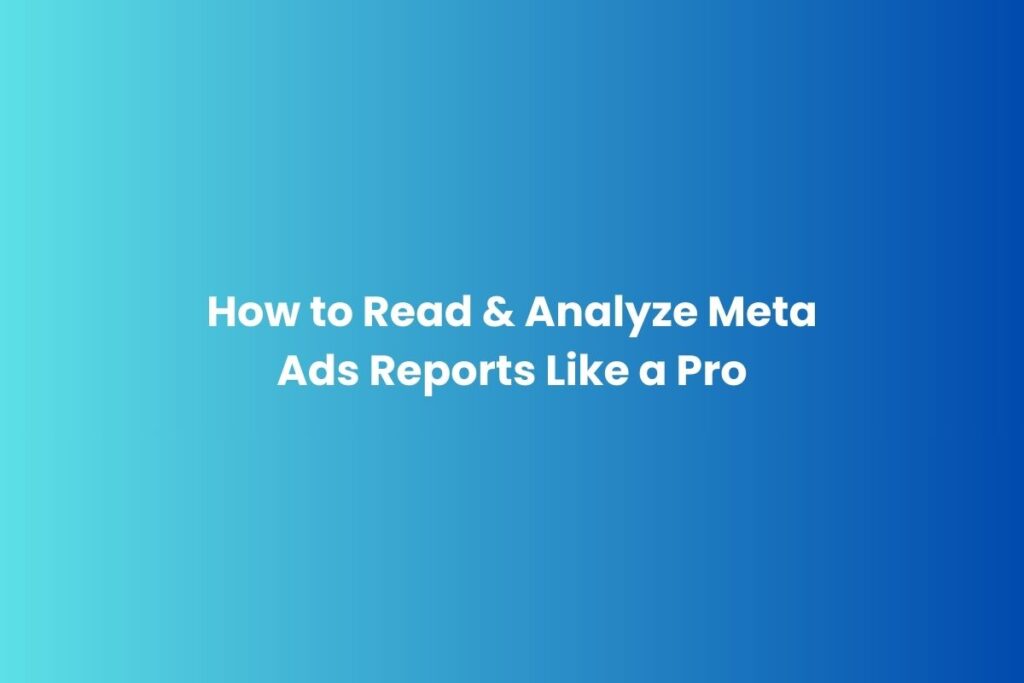
Ever launched a Meta Ads campaign, waited a few days, and then stared at the dashboard wondering…
“What do all these numbers mean?”
You’re not alone.
Meta Ads (Facebook + Instagram) can drive massive results — but only if you know how to read and analyze your reports the right way.
Because running ads is easy.
But reading data like a pro? That’s what separates profitable advertisers from budget burners.
In this blog, I’ll show you exactly how to read and analyze Meta Ads reports like a pro — step by step.
So the next time you open Ads Manager, you’ll know what’s working, what’s not, and what to fix.
Step 1: Start With Your Campaign Objective
Before diving into numbers, get clear on your goal.
Because metrics only matter when they match your objective.
Ask yourself:
- Is this campaign for awareness?
- Do I want traffic or engagement?
- Or am I driving conversions and sales?
Once you know the goal, focus only on the metrics that matter:
| Campaign Type | Key Metrics |
|---|---|
| Awareness | Reach, Impressions, CPM |
| Traffic | CTR, CPC, Landing Page Views |
| Engagement | Reactions, Comments, Shares |
| Conversions | CPA, Conversion Rate, ROAS |
Don’t get distracted by vanity metrics. Focus on numbers that tell you if your campaign is achieving its purpose.
Step 2: Master the Key Metrics
Now let’s decode the language of Meta Ads.
Here’s what each important metric actually means (and why it matters):
1. Impressions vs Reach
- Impressions = how many times your ad was shown
- Reach = how many unique people saw your ad
If your impressions are high but reach is low, you’re showing the same ad to the same people too often.
2. Frequency
- The average number of times one person saw your ad
If this goes above 3 or 4, ad fatigue can start. Time to refresh your creative.
3. CTR (Click-Through Rate)
- Shows if your ad grabs attention
A high CTR = great creative and copy
A low CTR = weak hook or wrong audience
4. CPC (Cost Per Click)
- How much you pay for each click
Lower CPC = efficient targeting
Higher CPC = fix creative or narrow audience
5. CPA (Cost Per Action)
- The cost of your desired action (purchase, lead, sign-up)
This is a core metric for conversion campaigns.
6. ROAS (Return on Ad Spend)
- Revenue ÷ Spend
If ROAS is above 3, you’re usually in profit.
If it’s below 1, something’s broken — fix your funnel.
Step 3: Customize Your Ads Manager View
Pro advertisers never use the default dashboard.
They customize columns based on campaign goals.
Here’s what to do:
- Click on “Columns” → “Customize Columns”
- Add the metrics that matter (CTR, CPC, CPA, ROAS)
- Save as a preset
This gives you a clean, focused report every time.
No more scrolling through irrelevant data.
Step 4: Break Down Your Data
Want to know where your money is working best?
Use Breakdowns.
You can analyze performance by:
- Age → Which age group clicks or buys more?
- Gender → Who’s more responsive?
- Placement → Is Feed or Reels giving better results?
- Device → Mobile vs Desktop performance
- Location → Which city or country converts best?
Example:
If “Stories” placement gives you cheaper leads than “Feed,” shift more budget there.
That’s how pros optimize — based on real data.
Step 5: Compare Time Periods
Data only makes sense in context.
Compare your results week over week or month over month.
Look for trends like:
- CTR dropping? → Creative fatigue
- CPA rising? → Audience saturation
- ROAS improving? → Stronger funnel
Never rely on one day’s performance. Always track patterns.
Step 6: Analyze Ad Sets and Ads Separately
Don’t stop at campaign-level data.
The gold is hidden in ad set and ad-level performance.
- At Ad Set Level: check audiences, placements, bidding.
- At Ad Level: review creatives, headlines, CTAs.
You’ll often find one creative outperforming all others.
Turn off poor performers and scale the winners.
Step 7: Watch the Full Funnel
Even the best ad can’t save a bad funnel.
So check beyond Meta:
- Is your landing page fast and mobile-friendly?
- Are forms short and easy?
- Is your pixel tracking correctly?
- Do you have remarketing setup?
A low conversion rate might not mean bad ads — it could mean bad experience after the click.
Use Meta Pixel + Conversions API for accurate tracking.
Step 8: Turn Data Into Insights
Data without action = useless.
Examples of insights:
- High CTR + Low Conversions → Landing page problem
- Low CTR + High CPC → Creative not connecting
- Great ROAS from one audience → Scale that ad set
- High CPA in one placement → Turn it off
Each number tells a story.
Your job is to translate it into action.
Step 9: Automate & Save Time
Meta lets you set automated rules.
Use them to optimize without babysitting campaigns.
Examples:
- Pause ad if CPA > $20
- Increase budget by 20% if ROAS > 4
- Notify me if CTR drops below 1%
Automation = smarter, faster decisions.
Step 10: Keep Testing & Learning
The best advertisers never stop testing.
Because what works today might fail tomorrow.
Keep experimenting with:
- New creatives
- Different audiences
- Fresh offers
- Updated landing pages
Every test gives you new insights.
Every insight leads to better performance.
Pro Tip: Create a Weekly Dashboard
Want a simple routine?
Do a weekly analysis with 4 sections:
- Key metrics (CTR, CPC, CPA, ROAS)
- Trends (Up or Down)
- Insights (What’s working)
- Actions (What to fix next)
It takes 30 minutes but saves hundreds in wasted spend.
Final Thoughts
Reading Meta Ads reports like a pro isn’t about memorizing numbers.
It’s about understanding what the data is telling you — where to spend more, what to cut, and how to grow profitably.
Once you learn to connect the dots — campaign goals, key metrics, audience behavior, and funnel — your Ads Manager becomes more than a dashboard.
It becomes your roadmap to ROI.
So the next time you open Meta Ads Manager…
Don’t just look at numbers.
Look for stories. Because every metric has a message.
Want Expert Help?
If you’re tired of guessing and want a professional to read your data, optimize your campaigns, and scale your ROAS —
📩 Let’s connect. I help e-commerce brands and service businesses turn ad reports into real profit.
